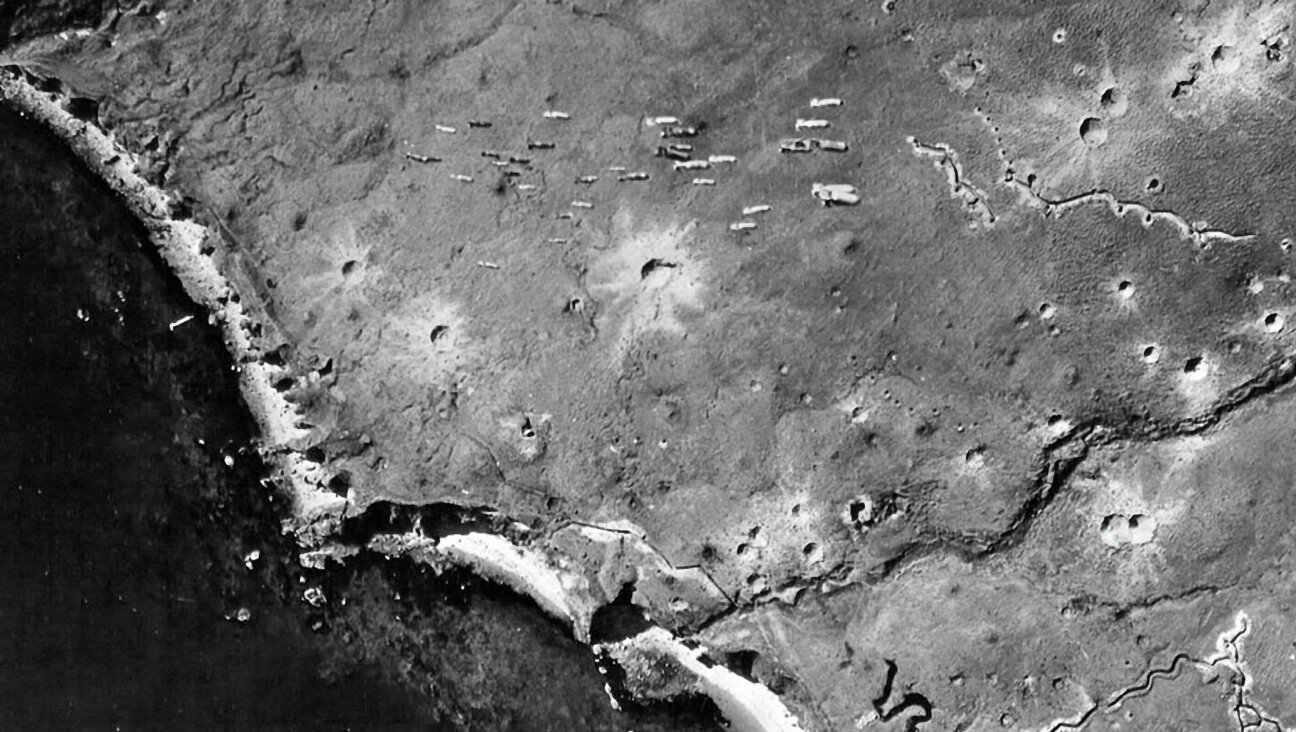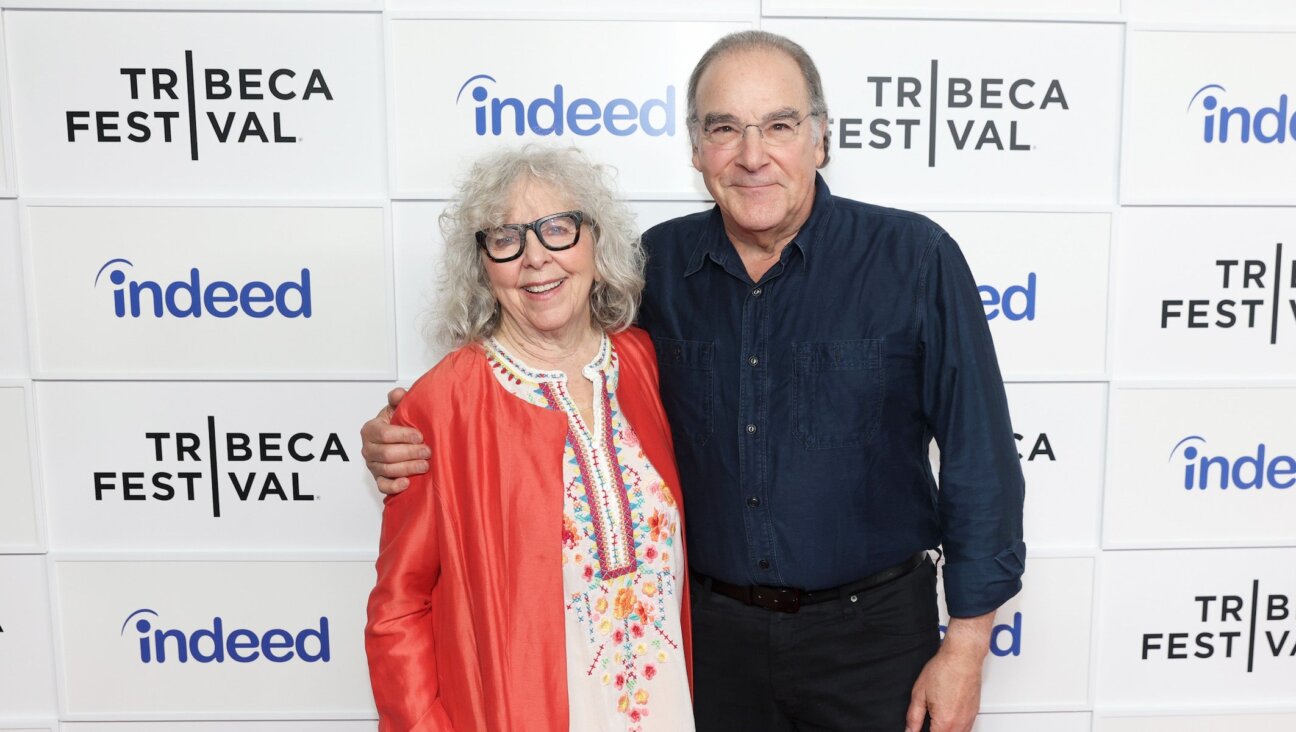John F. Kennedy’s Cold War Bunker Sits Off Florida’s Jewish Gold Coast

Graphic by Angelie Zaslavsky
The dingy, cavernous steel fallout shelter hastily built on a man-made island off Florida’s heavily Jewish ‘gold coast’ is a stark reminder of the harsh realities President John F. Kennedy faced from the first days of his presidency at the height of the Cold War.
As the Kennedy family vacationed minutes away at the Palm Beach compound known as the Winter White House, the shelter’s main chamber sat ready at a moment’s notice with 15 sets of bunk beds, a desk for the president and a conference table.
The heavily protected hideaway, fully stocked with military K rations, barrels of water and radiation detection kits, could serve as home for 30 of Kennedy’s family and key staff for a month in the event of a nuclear attack.
“They tested bringing him here,” said Anthony Miller, general manager of Palm Beach Maritime Museum, which maintains the shelter. “It was 10 minutes from his front door on Palm Beach to here.”
Shortly before Kennedy took office in January 1961, Navy Seabees undertook “Operation Hotel” and in 10 days piled 25 feet (7.6 metres) of earth, lead and concrete above the corrugated steel bunker.
Half a century after Kennedy’s assassination during a Dallas motorcade, his memory lingers in Palm Beach.
From his boyhood on, Kennedy’s family was a fixture in the ritzy, oceanside enclave where billionaire investors like William Koch rub shoulders with wealthy entertainers such as singer Jimmy Buffett.
The Honey Fitz, the yacht that served Presidents Truman through Nixon, still moors in the waters near the once-secret shelter. The 80-year-old wooden boat is a floating museum and travels regularly between Palm Beach and Hyannis Port, Massachusetts.
“All the footage you see of JFK out on the water during his presidency was on this boat and all of the still photos were taken on it,” said Paul Ocepek, the Honey Fitz’s first officer.
ESCAPE HATCH, HELIPAD
Getting to the fallout shelter’s main living quarters required passing through a series of narrow passages that held a generator, air pumps and filters, a radiation detector and a sterilization chamber.
At the back of the largest room was an emergency escape hatch that led to a helipad in case the shelter itself came under attack. The U.S. government did not acknowledge its existence until 1974.
The island where it sits was dredged up from the Palm Beach inlet in 1918 to serve as a port for peanut oil shipping.
Although that business failed, the name of Peanut Island remained. It was closed to the public from the time the Coast Guard took it over in 1936 in preparation for World War Two until 1995, when the museum secured a 45-year lease on the property.
At the time, the shelter was partially flooded and in disrepair, Miller said. Nearly all of its contents had been removed or destroyed.
The museum opened to the public in 1999, and efforts continue to restore the bunker to its original condition.
The steel hatch that leads to a dark, downward sloping steel tube was once hidden from sight by a thicket of trees. Miller said he planned to replant the trees, which for visitors will recreate the dramatic effect of stumbling upon the entrance in a small hill.
Despite the long-lasting interest in the Kennedys and their fairy-tale image, maintaining the shelter remains a challenge. It sees about 12,000 visitors annually and relies on volunteer efforts to help with maintenance.
It receives no financial contributions from the federal government or the Kennedy family, even though Ethel Kennedy, the widow of slain former Attorney General Robert F. Kennedy, visits the bunker almost every year with her grandchildren.
As the Kennedy family vacationed minutes away at the Palm Beach compound known as the Winter White House, the shelter’s main chamber sat ready at a moment’s notice with 15 sets of bunk beds, a desk for the president and a conference table.
The heavily protected hideaway, fully stocked with military K rations, barrels of water and radiation detection kits, could serve as home for 30 of Kennedy’s family and key staff for a month in the event of a nuclear attack.
“They tested bringing him here,” said Anthony Miller, general manager of Palm Beach Maritime Museum, which maintains the shelter. “It was 10 minutes from his front door on Palm Beach to here.”
Shortly before Kennedy took office in January 1961, Navy Seabees undertook “Operation Hotel” and in 10 days piled 25 feet (7.6 metres) of earth, lead and concrete above the corrugated steel bunker.
Half a century after Kennedy’s assassination during a Dallas motorcade, his memory lingers in Palm Beach.
From his boyhood on, Kennedy’s family was a fixture in the ritzy, oceanside enclave where billionaire investors like William Koch rub shoulders with wealthy entertainers such as singer Jimmy Buffett.
The Honey Fitz, the yacht that served Presidents Truman through Nixon, still moors in the waters near the once-secret shelter. The 80-year-old wooden boat is a floating museum and travels regularly between Palm Beach and Hyannis Port, Massachusetts.
“All the footage you see of JFK out on the water during his presidency was on this boat and all of the still photos were taken on it,” said Paul Ocepek, the Honey Fitz’s first officer.
ESCAPE HATCH, HELIPAD
Getting to the fallout shelter’s main living quarters required passing through a series of narrow passages that held a generator, air pumps and filters, a radiation detector and a sterilization chamber.
At the back of the largest room was an emergency escape hatch that led to a helipad in case the shelter itself came under attack. The U.S. government did not acknowledge its existence until 1974.
The island where it sits was dredged up from the Palm Beach inlet in 1918 to serve as a port for peanut oil shipping.
Although that business failed, the name of Peanut Island remained. It was closed to the public from the time the Coast Guard took it over in 1936 in preparation for World War Two until 1995, when the museum secured a 45-year lease on the property.
At the time, the shelter was partially flooded and in disrepair, Miller said. Nearly all of its contents had been removed or destroyed.
The museum opened to the public in 1999, and efforts continue to restore the bunker to its original condition.
The steel hatch that leads to a dark, downward sloping steel tube was once hidden from sight by a thicket of trees. Miller said he planned to replant the trees, which for visitors will recreate the dramatic effect of stumbling upon the entrance in a small hill.
Despite the long-lasting interest in the Kennedys and their fairy-tale image, maintaining the shelter remains a challenge. It sees about 12,000 visitors annually and relies on volunteer efforts to help with maintenance.
It receives no financial contributions from the federal government or the Kennedy family, even though Ethel Kennedy, the widow of slain former Attorney General Robert F. Kennedy, visits the bunker almost every year with her grandchildren.


















